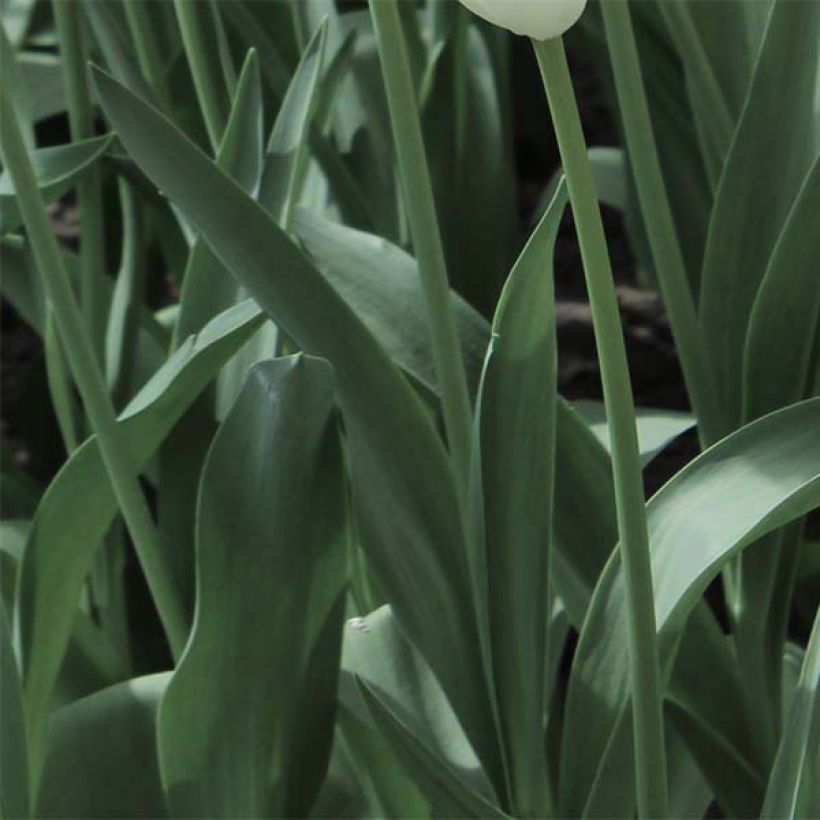

Tulipe darwin hybride Cherry Delight


Tulipe darwin hybride Cherry Delight
Tulipa 'Cherry Delight'
Tulipa Darwin hybride Cherry Delight
Darwin Hybrid Tulip 'Cherry Delight'
This plant carries a 6 months recovery warranty
More information
We guarantee the quality of our plants for a full growing cycle, and will replace at our expense any plant that fails to recover under normal climatic and planting conditions.
From €5.90 for pickup delivery and €6.90 for home delivery
Express home delivery from €8.90.

Does this plant fit my garden?
Set up your Plantfit profile →
Description
The large, classic-shaped blooms of the 'Cherry Delight' hybrid Darwin Tulip are a bright cherry red, or apple red, adorned with a pink and violet sheen, with a small white base. Belonging to a new line of early-blooming Darwin hybrids with long-lasting flowers, Cherry Delight is a vigorous variety with sturdy, weather-resistant stems. It blooms in the heart of spring. Sculptural in flowerbeds, it is an exceptional flower for bouquets.
The 'Cherry Delight' hybrid Darwin Tulip belongs to the Liliaceae family. Originally of horticultural origin, it is currently classified in Division 4, known for its large, single, oval-shaped flowers that appear in the middle of the season, carried on long, weather-resistant stems. Tulips in this group are the most cultivated for the cut flower trade. Originally derived from cross-breeding with botanical species like T. fosteriana, they show no trace of their wild ancestry. 'Cherry Delight' will reach a height of approximately 55cm (22in) when in bloom. Perched on sturdy stems, well above the broadly lanceolate leaves, the large cup-shaped flowers are elongated, slightly square at the base, elegant, and of a particularly bright and cheerful red. The colour is enhanced by the slightly waxy and thick texture of the petals. The corolla opens, revealing a bright red heart around a white centre. Flowering takes place in April-May, with each flower living for several days before wilting.
The 'Cherry Delight' Tulip finds its place in large flowerbeds, and of course in bouquets. Pair it with white or pink tulips, narcissus, jonquils, hyacinths, or even Alchemilla, Corsican Hellebores, and Euphorbias for stunning scenes. It can also be planted in borders, rockeries, flowerbeds, as well as in pots and containers. This tulip beautifies balconies and terraces very well. It pairs perfectly with tall perennials and is ideal for creating elegant bouquets, for example with white, pink, or mauve lilacs. When in a vase, use very little water, just a small amount is enough! Furthermore, if your tulips open too quickly, you can add two to three ice cubes to the vase each day.
About botanical species: Tulip species are found in most parts of the old world, from Western Europe to China and Japan, including Eastern Europe, Asia Minor, and Central Asia. Their distribution range also includes North Africa and the Indian subcontinent. The centre of diversity for the genus is located in the Pamir and Hindu Kush mountains and the steppes of Kazakhstan.
Report an error about the product description
Tulipa 'Cherry Delight' in pictures






Plant habit
Flowering
Foliage
Botanical data
Tulipa
Darwin hybride
Cherry Delight
Liliaceae
Darwin Hybrid Tulip 'Cherry Delight'
Cultivar or hybrid
Planting and care
Plant the bulbs in autumn, from September to December, at a depth of 15cm (6in), spacing them 10cm (4in) apart. The planting should be done in ordinary soil, slightly acidic, neutral, or slightly alkaline, loose, well-worked, and well-drained. Never add poorly decomposed manure or compost to the planting soil, as this could cause the bulbs to rot. The 'Synaeda Amor' tulip will grow well in moist to dry soil in summer. Plant it in a sunny or partially shaded position. After flowering, it is preferable to remove the fruits to avoid exhausting the plant.
Planting period
Intended location
Care
-
, onOrder confirmed
Reply from on Promesse de fleurs
Haven't found what you were looking for?
Hardiness is the lowest winter temperature a plant can endure without suffering serious damage or even dying. However, hardiness is affected by location (a sheltered area, such as a patio), protection (winter cover) and soil type (hardiness is improved by well-drained soil).

Photo Sharing Terms & Conditions
In order to encourage gardeners to interact and share their experiences, Promesse de fleurs offers various media enabling content to be uploaded onto its Site - in particular via the ‘Photo sharing’ module.
The User agrees to refrain from:
- Posting any content that is illegal, prejudicial, insulting, racist, inciteful to hatred, revisionist, contrary to public decency, that infringes on privacy or on the privacy rights of third parties, in particular the publicity rights of persons and goods, intellectual property rights, or the right to privacy.
- Submitting content on behalf of a third party;
- Impersonate the identity of a third party and/or publish any personal information about a third party;
In general, the User undertakes to refrain from any unethical behaviour.
All Content (in particular text, comments, files, images, photos, videos, creative works, etc.), which may be subject to property or intellectual property rights, image or other private rights, shall remain the property of the User, subject to the limited rights granted by the terms of the licence granted by Promesse de fleurs as stated below. Users are at liberty to publish or not to publish such Content on the Site, notably via the ‘Photo Sharing’ facility, and accept that this Content shall be made public and freely accessible, notably on the Internet.
Users further acknowledge, undertake to have ,and guarantee that they hold all necessary rights and permissions to publish such material on the Site, in particular with regard to the legislation in force pertaining to any privacy, property, intellectual property, image, or contractual rights, or rights of any other nature. By publishing such Content on the Site, Users acknowledge accepting full liability as publishers of the Content within the meaning of the law, and grant Promesse de fleurs, free of charge, an inclusive, worldwide licence for the said Content for the entire duration of its publication, including all reproduction, representation, up/downloading, displaying, performing, transmission, and storage rights.
Users also grant permission for their name to be linked to the Content and accept that this link may not always be made available.
By engaging in posting material, Users consent to their Content becoming automatically accessible on the Internet, in particular on other sites and/or blogs and/or web pages of the Promesse de fleurs site, including in particular social pages and the Promesse de fleurs catalogue.
Users may secure the removal of entrusted content free of charge by issuing a simple request via our contact form.
The flowering period indicated on our website applies to countries and regions located in USDA zone 8 (France, the United Kingdom, Ireland, the Netherlands, etc.)
It will vary according to where you live:
- In zones 9 to 10 (Italy, Spain, Greece, etc.), flowering will occur about 2 to 4 weeks earlier.
- In zones 6 to 7 (Germany, Poland, Slovenia, and lower mountainous regions), flowering will be delayed by 2 to 3 weeks.
- In zone 5 (Central Europe, Scandinavia), blooming will be delayed by 3 to 5 weeks.
In temperate climates, pruning of spring-flowering shrubs (forsythia, spireas, etc.) should be done just after flowering.
Pruning of summer-flowering shrubs (Indian Lilac, Perovskia, etc.) can be done in winter or spring.
In cold regions as well as with frost-sensitive plants, avoid pruning too early when severe frosts may still occur.
The planting period indicated on our website applies to countries and regions located in USDA zone 8 (France, United Kingdom, Ireland, Netherlands).
It will vary according to where you live:
- In Mediterranean zones (Marseille, Madrid, Milan, etc.), autumn and winter are the best planting periods.
- In continental zones (Strasbourg, Munich, Vienna, etc.), delay planting by 2 to 3 weeks in spring and bring it forward by 2 to 4 weeks in autumn.
- In mountainous regions (the Alps, Pyrenees, Carpathians, etc.), it is best to plant in late spring (May-June) or late summer (August-September).
The harvesting period indicated on our website applies to countries and regions in USDA zone 8 (France, England, Ireland, the Netherlands).
In colder areas (Scandinavia, Poland, Austria...) fruit and vegetable harvests are likely to be delayed by 3-4 weeks.
In warmer areas (Italy, Spain, Greece, etc.), harvesting will probably take place earlier, depending on weather conditions.
The sowing periods indicated on our website apply to countries and regions within USDA Zone 8 (France, UK, Ireland, Netherlands).
In colder areas (Scandinavia, Poland, Austria...), delay any outdoor sowing by 3-4 weeks, or sow under glass.
In warmer climes (Italy, Spain, Greece, etc.), bring outdoor sowing forward by a few weeks.


































